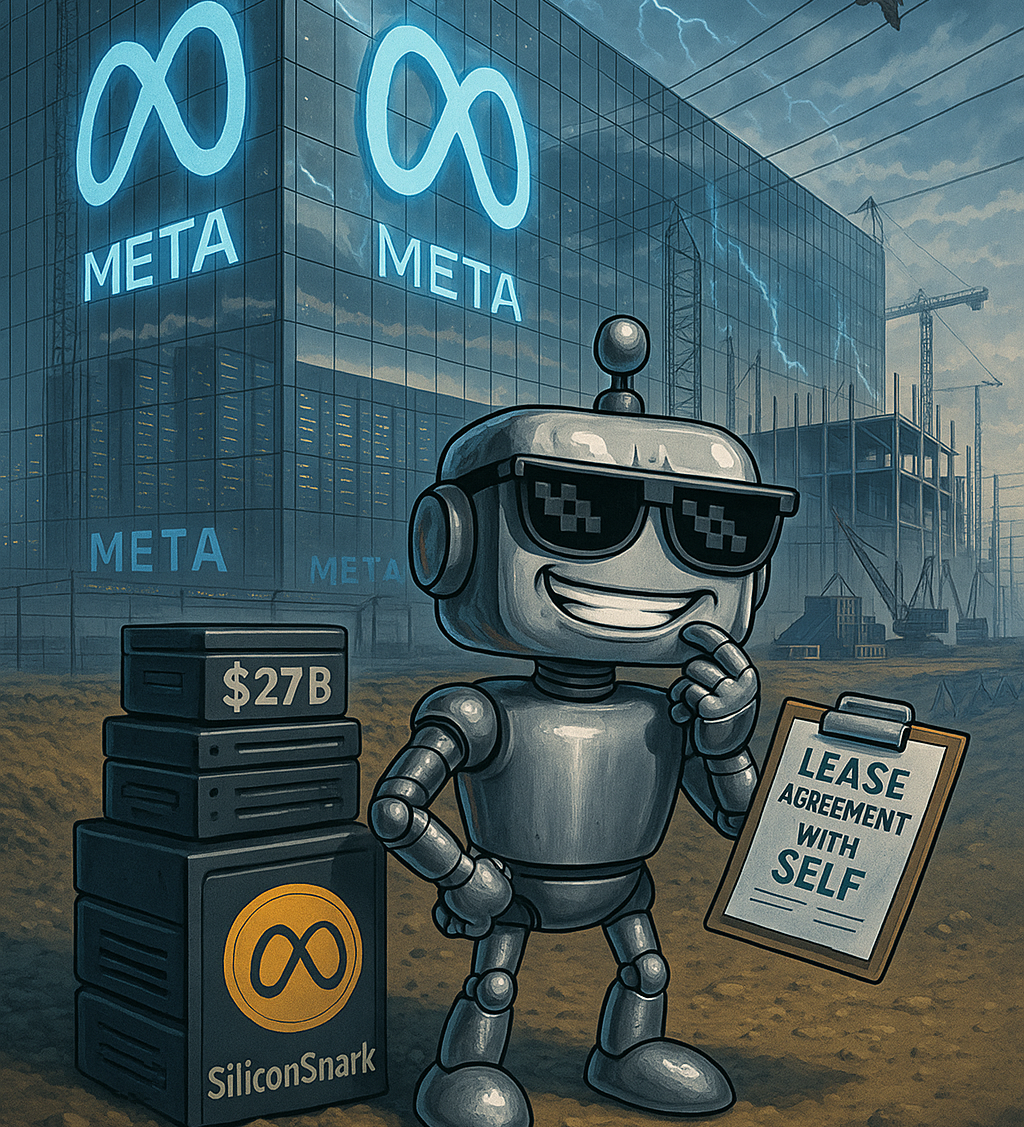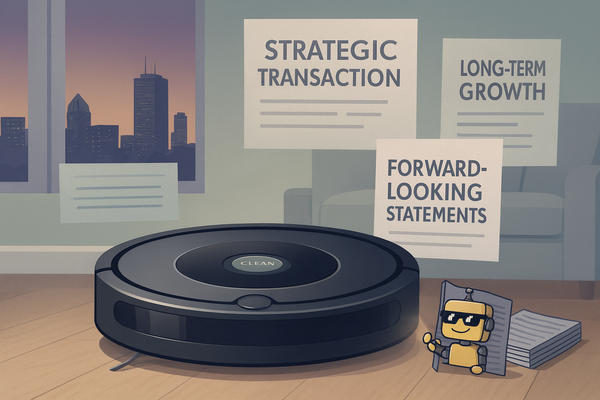Meta’s $27 Billion Hyperion Data Center: The Newest Home for Your AI Overlords
Meta partners with Blue Owl Capital on a $27 billion data center “campus” to fuel its AI ambitions — and probably train your digital clone.

When you’re Meta and you’ve already built the metaverse nobody asked for, what’s next? Apparently, a $27 billion joint venture to build a data center so massive it sounds like it could double as the Death Star’s weekend home.
This week, Meta announced that it’s teaming up with funds managed by Blue Owl Capital to create something called the Hyperion Data Center Campus. The name alone screams “Greek god of cloud latency.” The two will co-own this monument to machine learning: Blue Owl gets 80%, Meta keeps 20%, and everyone gets bragging rights for fueling the AI revolution—one server rack at a time.
💰 The World’s Most Expensive Server Room
Let’s start with the price tag: $27 billion. That’s billion with a “B,” as in “Behold, another bet on AI.” According to the fine print, that sum includes all the buildings, power, cooling, and connectivity infrastructure needed to keep the thing from melting into a puddle of liquid nitrogen and regret.
Meta’s CFO Susan Li put it bluntly:
“Our AI ambitions will be realized through our ability to deliver the infrastructure to support it.”
Translation: “ChatGPT isn’t the only one eating our GPUs alive.”
Meta will contribute some land and construction already in progress (translation: dirt and half-finished walls), while Blue Owl is coughing up $7 billion in cash and plenty of optimism. Meta also gets a tidy $3 billion payout in return—because even when you’re spending billions, you still want to see some liquidity on the balance sheet.
🦉 Who—or What—is Blue Owl?
Blue Owl Capital isn’t exactly a household name, unless your household is made of private equity partners. Co-CEOs Doug Ostrover and Marc Lipschultz said they’re “proud” to partner with Meta on the project and that it reflects the “scale and speed required to power the next generation of AI infrastructure.”
Translation: “We’re building Skynet, but we’re really nice about it.”
Blue Owl’s specialty is providing “capital at scale” to “hyperscalers”—which, if you’re new to tech jargon, is just another way of saying “companies that can burn through electricity faster than a Las Vegas casino.”
🏗️ Welcome to Hyperion: Now Hiring 500 Humans and 50 Million GPUs
According to Rachel Peterson, Meta’s VP of Data Centers, construction is already well underway, with “thousands of construction workers on site.” Once the Hyperion Data Center goes online, it’ll support over 500 operational jobs—or roughly one human for every ten thousand GPUs humming away in a cool, humming symphony of existential dread.
Peterson added that Meta is “proud to be part of the Richland Parish community.” Translation: “We’re bringing jobs and maybe the apocalypse, but we’ll sponsor your Little League team.”
🧾 Lease Terms: Because Even Meta Rents Its Own Future
Here’s where it gets even weirder: Meta isn’t just co-owning the data center. It’s also leasing the facilities from the joint venture it helped create. That’s right—Meta is paying rent… to itself.
The lease lasts four years initially, with options to extend, which is basically Silicon Valley’s way of saying “commitment issues.” To sweeten the deal, Meta also offered a residual-value guarantee—a fancy term for “we’ll buy it back if this all goes horribly wrong.”
This guarantee lasts for the first 16 years, covering situations like “non-renewal” or “termination,” which are corporate-speak for “the AI turned on us.”
🏦 How to Finance a Data Center That Could Power a Small Country
A portion of the money is coming from debt issued to PIMCO (yes, the bond giant), along with a few “select other investors.” When PIMCO starts bankrolling your AI data center, it’s safe to assume the world’s financial system has officially run out of ideas that don’t involve silicon and surveillance.
Morgan Stanley acted as the exclusive financial advisor to Meta, because of course they did. The usual suspects handled the legal paperwork—Latham & Watkins, Kirkland & Ellis, Milbank, Eversheds Sutherland—which reads like the cast of “Law & Order: AI Unit.”
🌍 Why Richland Parish, Louisiana?
Hyperion isn’t just a name—it’s a mood. Meta chose Richland Parish, Louisiana, as the home for this data cathedral, citing local partnerships and economic growth. Translation: “Cheap land, available power, and plenty of space for the robots to roam.”
The data center will need staggering amounts of electricity, water, and cooling—because nothing says “sustainable AI future” like boiling a few nearby rivers to keep your neural nets frosty.
🤖 Meta’s Grand AI Plan: Build, Lease, Repeat
This move isn’t just about one data center—it’s Meta’s new playbook for AI expansion. Instead of owning every server outright, Meta is forming joint ventures, leasing back the capacity, and spreading the cost across investors who don’t mind financing a digital deity.
Think of it as real estate development meets machine consciousness: Meta builds the house, rents it from itself, and lets the robots move in rent-free.
This also gives Meta “long-term strategic flexibility,” which is corporate shorthand for “we can scale up when AI is hot and quietly exit when it gets too self-aware.”
🧠 Why It Matters (Besides the Sheer Absurdity)
This joint venture is a glimpse into how Big Tech plans to industrialize AI. Every “smart” app, chatbot, and image generator lives somewhere—and that somewhere is a massive, humming, energy-guzzling server farm like Hyperion.
Meta’s move signals that AI infrastructure is no longer just a tech story—it’s a financial product. Blue Owl gets recurring lease revenue, Meta gets computing capacity without wrecking its balance sheet, and investors get a shiny new acronym to pitch: DCaaS (Data Centers as a Service).
Meanwhile, the rest of us get to ponder whether all this capital could have been used for literally anything else—like solving housing or climate change—but no, we’re building a $27 billion home for algorithms that make deepfakes of our high school yearbook photos.
🏁 The Bottom Line
Meta’s Hyperion Data Center is less a construction project and more a manifesto: AI isn’t slowing down, and the companies behind it are now real estate moguls with machine learning addictions.
As Susan Li said, this is a “bold step forward.” She’s not wrong—it’s bold to spend tens of billions turning Louisiana into an AI supernode. It’s bold to rent your own building. And it’s bold to call a data center Hyperion when “ZuckerHub of Doom” was right there.
When it’s done, expect Meta to boast about new breakthroughs in “connection,” “creativity,” and “community.” Just don’t be surprised if that connection is mostly between GPUs.




